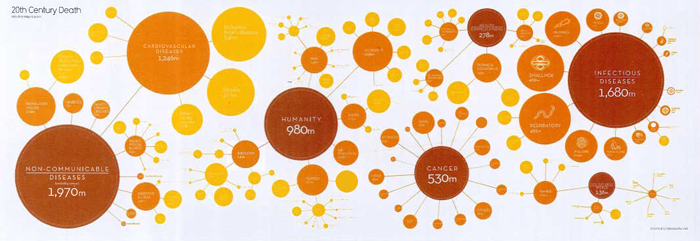Activity 1
Introduction
Have students read the introduction to the module, Discovering the Microbial World. The purpose of this reading is to provide students with an historical perspective on the discovery of microorganisms, provide them with a short introduction to microorganisms and inform them of what they will be exploring in the module.
Activity
In this first activity students are challenged to identify the origins of different diseases. Two alternatives of the activity are provided. In the first (A: Infectious or Noninfectious) students sort the diseases into two categories—infectious and noninfectious.
The second alternative (B: Infectious, Noninfectious, Inherited, or a Combination of Factors) provides a more nuanced and complex analysis and is designed to have students recognize that the origins of some diseases can be classified in more than one category. The purpose of this activity is to determine students’ prior understandings about the origins of certain diseases and to have them begin to consider what makes a disease “infectious.”
Both activities can be carried out by individuals, by teams or as a whole class activity. You can choose to have students complete the activity individually or in teams online with the interactive sorting activity or physically using the Randomized List of Diseases handout.
Answer Key: A
| Infectious | Noninfectious |
|---|---|
| AIDS | Haemophilia |
| Ebola | Sickle Cell Disease |
| Measles | Down Syndrome |
| Malaria | Anorexia |
| Influenza | Cervical Cancer |
| Tuberculosis | Lung Cancer |
| COVID-19 | Miner's Black Lung |
| Scurvy | |
| Breast Cancer | |
| Skin Cancer | |
| Asthma | |
| Alzheimer's |
Answer Key: B
| Infectious Diseases | Inherited Diseases (noninfectious) | Environmental Diseases | Combination of Factors |
|---|---|---|---|
| AIDS | Haemophilia | Asthma | Breast Cancer |
| Ebola | Sickle Cell Diseaser | Scurvy | Lung Cancer |
| Measles | Down Syndrome | Miner's Black Lung | Skin Cancer |
| Malaria | Alzheimer's Disease | ||
| Influenza | Cervical Cancer | ||
| Tuberculosis | Anorexia | ||
| COVID-19 |
Discussion
The purpose of this discussion is to have students consider the differences between infectious diseases and noninfectious (genetic and environmental) diseases. You may want to initiate discussion with questions such as:
-
Which diseases fall into more than one category? How might you explain this?
The purpose of this question is to have students consider that in some cases a disease is defined by its symptoms, for example breast cancer, whereas other diseases are defined by the causes such as measles.
-
Food poisoning is generally categorized as an infectious disease because it is usually caused by bacteria (such as E. coli). However, you cannot infect other people with your food poisoning as you can infect them with measles. Why are food poisoning and measles both considered infectious diseases?
Because both diseases are caused by organisms that can spread throughout a population, they are considered infectious diseases. Students will explore different modes of transmission of infectious agents in the next reading.
-
Bacteria cause tuberculosis, a virus causes Ebola, and malaria is caused by a parasite. Why, then, are all three considered infectious diseases? What do these infectious agents have in common in their structures and functions? in how they might cause disease? how do they differ?
The purpose of this question is to determine how much students already know about infectious agents. Assure them that they may not know answers to these questions now but will be learning about agents of infectious disease in the rest of the module.
-
How might diseases in each category be prevented? For one or more diseases in each category, consider ways that individuals and communities might prevent infectious, genetic, and environmental diseases. What social or ethical issues might arise in designing policies for disease prevention?
The purpose of this question is to have students begin to think about social, economic, ethical, and cultural issues related to the causes and prevention of disease. Students may propose policies for preventing environmentally caused diseases such as anti-smoking campaigns or by preventing toxic waste in water or soil.
Policies for preventing infectious diseases might include requirements for vaccination, ensuring clean water, eradication of certain insects such as mosquitoes, and other public health measures. Issues related to preventing infectious diseases are explored in depth in subsequent modules. Discussion of policies related to preventing genetic diseases could bring up discussions that may not be appropriate for some students or classes.
You may want to discuss the figure Causes of Mortality in the 20th Century, which compares numbers of deaths by various causes. You may want to point out that infectious diseases cause almost as many deaths as noninfectious diseases, both of which have been the major causes of death in this century.

20th Century Death. Click on the image above to view an enlarged version.
Courtesy of www.informationisbeautiful.net
-
What information does this graphic tell you about the importance of infectious diseases in the 20th century in the U.S.?
The graphic indicates that infectious diseases are still of major importance in the U.S.
Follow-up Activity: Based on the discussion about each kind of disease, have students develop a definition for an infectious disease. You may want students to revise their definitions at the end of this module.